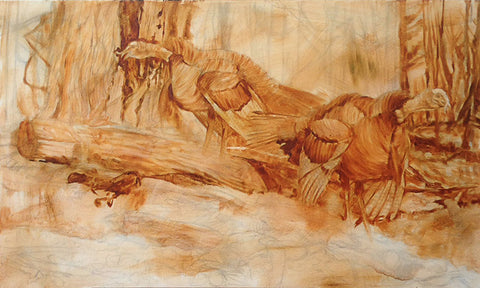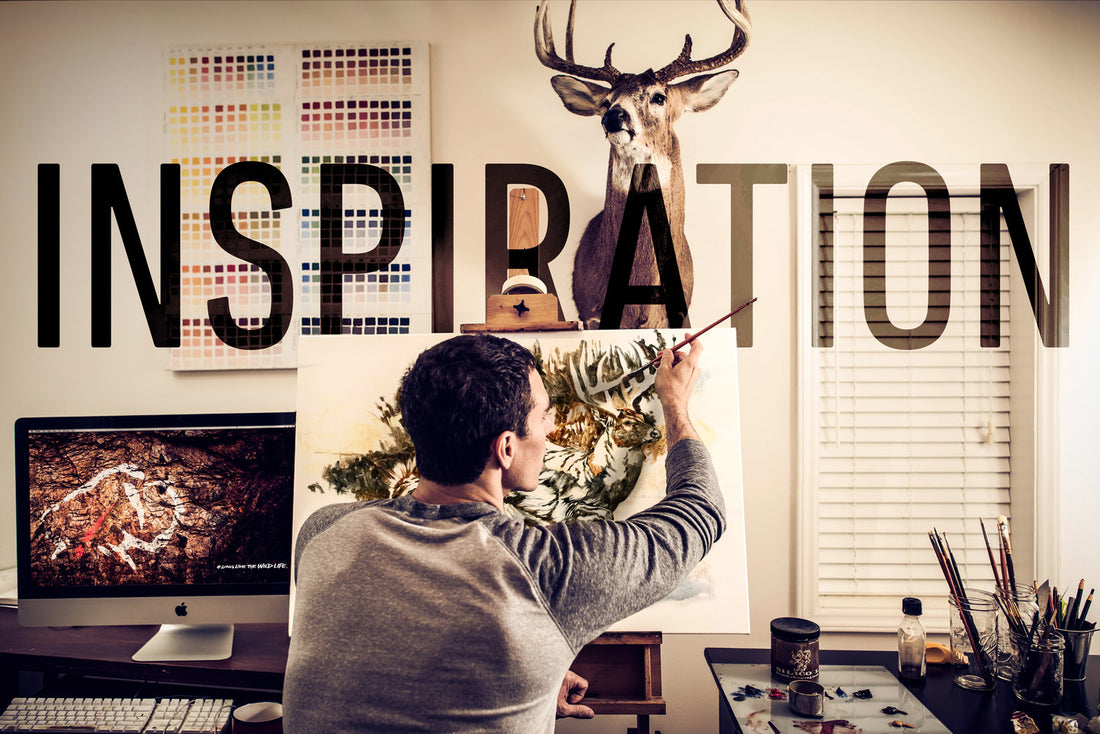“What inspires you to create your art?”
I get asked this question all the time in conversations about wildlife art. Sometimes it comes up at an art show. It’s often in the lineup of questions for an interview. Most times it’s preceded by a comment like “shoot man, I can’t even draw a stick figure” or “you ever hear of that guy with the afro that painted happy trees and stuff? What was his name….Bob Ross! You ever watch that guy?”
Recently, it came up in a letter from a young dude named Casey who actually took the time to find my business mailing address online and mail a handwritten letter. I was impressed, so I hooked him up with some apparel and figured I’d elaborate in this blog post.

My canned answer for an interviewer who asks about inspiration is something along the lines of: “Well, I really enjoy the outdoors and my experiences field hunting and fishing are what fuel my work.”
That answer is fine, and it’s totally true, but it’s just the tip of the iceberg. You see, I really, really love to hunt. I love being outdoors. I love the early morning strategy session, sipping coffee around a kitchen table or driving down a gravel road an hour before daylight. I love the adrenaline packed, almost surreal, moment when you finally see the game you’re after. I love the challenge and the demands of hunting. I love that, to be successful, it requires you to learn new things about the animals and their habitat, to test yourself against the elements, the terrain and the topography. I love the common bonds that unite hunters and the high-fives over flopping turkeys that bring family and friends closer together.
I realize that’s a lot of “love” in one paragraph, but it’s true. Hunting is an art, and the pursuit of any art has always inspired more art. I also realize that terms like “inspiration” are sort of wishy-washy and vague. Most people want to hear the nuts and bolts of creating art. And, let’s face it, sometimes creating art is more of a methodical grind than a flash of genius anyway. So I’ll elaborate in a bit more of a defined way.
Throughout my career, I’ve noticed two fairly distinct sparks that inspire me to paint: a setting, or a scenario.
A Setting
This happens most often while turkey hunting, and it usually happens when a roost hunt turns out to be a bust and we’re moving to a new setup. Why? Well, first I’m on ground level during turkey season, which doesn’t happen 20 feet up a tree during deer season. Being at eye level with your quarry opens up new perspectives and angles and horizon lines that you don’t see from an elevated deer stand. You’re relating to the habitat at eye level with the animal, which is almost always how I paint them.
Second, the sun has typically just come up and the landscape is struck with warm, golden sunshine. I like to paint this light. It’s what photographers call “The Golden Hour” and sometimes refer to this light as “buttery.” Couples in love get their engagement photos taken this time of day because it’s flattering and we look better then. So do deer. (Also like humans, it’s usually the doe dragging the buck out of hiding for this event, and he only does it because he’s in love...)
Last but not least, I’ve left the focused intensity of trying to kill a bird off the roost and have started to take in the surroundings again. You know how it goes. You’re stone still, motionless at the thought of a potential longbeard roosted overhead in the dark or waiting for his thunderous gobble to top the crest of the hill. Once the roost hunt is over though, you look around and take in the scenery as you gameplay your next move. When you relax and the laser focus subsides, you tend to notice things around you, and these observations and little details make all the difference.
This is how it happened with “Sons of Thunder,” one of my most popular and successful pieces. Our roost hunt was a bust, with the birds pitching down off the crest of the mountain to the pasture hundreds of feet below. As we headed back to the truck to maneuver around, a sunlit log on the crest of a hardwood ridge hit my eye. I like logs and rocks that give structure to a scene, as opposed to the sometimes monotonous pattern of leaves and sticks that cover the forest floor. There was an interplay of warm and cool light that I was drawn to, and I imagined two thunderous two-year olds hammering simultaneously atop the ridge in the early hours of the day.
I took several reference photos of the scene, then worked with photographer Tes Jolly on reference of the gobbling turkeys. She had a series of longbeard photos with the pose and lighting that I wanted for the scene. Once back in my studio, I laid down the composition and got to work painting the scene as I pictured it in my head. The result is “Sons of Thunder.”
The series of images below show the process of “Sons of Thunder” start to finish, from the initial reference photo while hunting to the finished piece in my studio. Limited Edition Prints Available Here







A Scenario
Animals do some really cool things. Whitetail bucks rub saplings, scrape, fight and chase does. Turkeys gobble and strut. Elk bugle and lumber around, herding their cows amidst a constant barrage of satellite bulls waiting to betray them. It’s amazing to watch, whether it’s with a bow or camera in hand. There’s times when I even prefer to have a camera, as you learn a lot more about an animal’s body language and behavior when you’re actually watching them and not trying to figure out when to draw and where your shot is going to be. Adrenaline makes us hyper focused by design. On the other hand, simple observation allows our curiosity to take over and really learn from the animals themselves.
For example, I witnessed a big six-point making a scrape in IL one year. When he first appeared, his large body and frame had me instantly reaching for my bow. Once I realized he wasn’t what I was looking for, I hung my bow back up and simply watched the show. He did everything you dream about whitetails doing. He worked over a licking branch with his preorbitals, ravaged a leafy oak with his rack and pawed out the dirt like a designated hitter digging in for the most important at-bat of his career. He soaked his tarsals with urine, grunted, bristled and postured. It was really pretty epic. And for a six pointer, he was remarkably large-bodied and athletic looking.
I knew I wanted to recreate the scene, but observing it from 20 feet up, I didn’t have the angle I needed for photos. So I simply made mental notes of the pose and the cool, overcast lighting of that November day. With no pressure to execute a shot on him, I was able to really take in the scenario and embed the details in my mind.
I ended up punching a tag on a bruiser a day later on that trip, but the memory of watching that big six work a scrape was stuck in my head. Upon returning to my studio in NC, I worked with photographer Don Jones and found the reference photos I needed to paint the scene from ground level. I took some liberty with the rack, painting him as a heavy-framed 10-point and the end result is “Scrape Line.” Of course I’m biased, but I’ve always felt this is the ultimate man-cave piece. The original is sold, but you can Purchase a Limited Edition Print Here.




2 comments